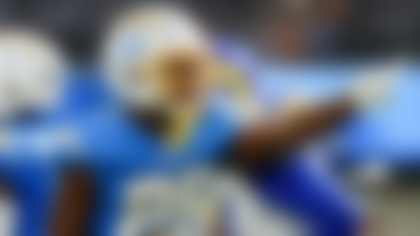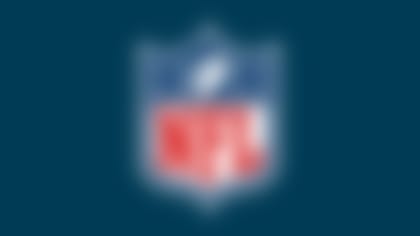In his robust Inside The NFL Notebook, NFL Media's Albert Breer touches on multiple topics, including (click on each link to take you directly to the topic):
» A common problem in the 0-4 starts of the Giants and Steelers.
» A financial conundrum for the defending Super Bowl champions.
» Potential candidates for the USC job.
» And much more, beginning with the impact ex-basketball players continue to make in football ...
The Denver Broncos' new stud tight end might not know it all about football yet, but he knows a few things about another sport. So when Julius Thomas is asked if any of his teammates could take him one-on-one in basketball, he isn't beat off the dribble to the answer.
"No chance."
Could any come close?
"Two words, buddy," Thomas reiterates with a laugh. "No. Chance."
As it turns out, he's pretty competitive with those guys in football, too.
Thomas is only one of many to seamlessly transition from hardwood hero to tight end in the NFL, where the term "box out" is becoming as common as "seal block" or "in-cut." New Orleans Saints star Jimmy Graham, who played four years of basketball and only one year of football at the University of Miami, was just named NFC Offensive Player of the Month. Jordan Cameron also started college as a basketball player and is emerging for the Cleveland Browns. Antonio Gates remains the patron saint of the genre.
Then there's Thomas, who has 18 catches for 237 yards and four touchdowns in four games as part of a Denver skill group overcrowded with talent. The third-year Bronco didn't play football in high school, and when intrigued by the sport as a Portland State freshman, his basketball coaches told him he first had to exhaust his hoops eligibility. So after an illustrious career on the court, Thomas went out for football in his fifth year and showed enough to convince the Broncos to spend a fourth-round draft pick on him in 2011.
Thomas' athleticism, at 6-foot-5 and 250 pounds, never was a question. But Thomas said the light didn't really turn on for him until last spring, after two injury-plagued seasons.
"No question, it's still a battle," he said. "There are still things I struggle with. I always say, I learn more than any other player every practice. There are so many situations where you don't know how to react, what technique to use. This is still my first year getting a lot of playing time. It's a learning process."
Conversely, the upside with these 6-5 collegiate power forwards is so great that NFL teams are doing all they can to make sure they aren't caught flatfooted on the next Gates.
Schein: Week 5 bold predictions

The Philadelphia Eagles have taken it to another level, assigning a scout to watch college basketball. Other teams ask their area guys to inquire about college hoops players whose skills might translate. Former Green Bay Packers general manager Ron Wolf used to staff the NBA's pre-draft camp in Portsmouth, Va.
Most guys don't make it. Enough do, though, to make it worth investing in the evaluation.
"Look around the league, and you see the athletes who are winning those one-on-one matchups -- a lot of them have a basketball background -- and we wanted to make sure we're researching guys that might be part of the next wave," Eagles GM Howie Roseman said. "Most of the guys, you see them, you don't know if they'll have the chance to play in the NBA, based on their body type. But that (6-5 power forward) body type is perfect for football."
More traditional prospects bolster the idea.
Tony Gonzalez played both sports at Cal. Martellus Bennett, who initially declared for the NBA draft out of high school, played hoops and football at Texas A&M. Marcedes Lewis played both sports during his freshman year at UCLA. And many others were high school basketball superstars.
Gates' story is a little different. He was a star recruit in both sports and went to Michigan State, where Nick Saban informed him he couldn't play basketball. Gates bounced around from there, eventually landing at Kent State to play hoops. But he never lost his basic football skills and quickly reassimilated when given the chance, becoming a starter for the San Diego Chargers midway through his rookie year after signing with the team as an undrafted free agent.
"I think he played basketball like a football player," said Clancy Barone, who coached Gates in San Diego and now is Thomas' position coach in Denver. "I watched his tape from Kent State, and he was physical, he had that body type, 265 pounds. In his mind, he probably never stopped playing football. He just stopped doing it on the football field for a while."
Those who saw Gates' amazing rise always identify it as an outlier: "The short answer is that if we knew, we would've drafted him," said John Spanos, the Chargers' executive vice president of football operations. "Any team would have. We saw a lot of athletic ability, but Antonio deserves the credit. You have to work hard, and he worked real hard, and made great strides quickly."
More common is a situation like the one unfolding now in Kansas City.
The Chiefs tried out ex-Wisconsin-Milwaukee power forward Demetrius Harris in the spring and, according to GM John Dorsey, watched the former Arkansas all-state high school receiver "catch the crap out of the ball." The process has been slow and steady since, but Harris showed enough promise to make the practice squad.
"Watching how he played basketball, you ask the questions, 'As he works in the paint, is he physical? As he works in the paint, does he catch the ball? Does he have good footwork?' " Dorsey said. "And then you put him through a football workout."
Is the idea of a football evaluator watching basketball tape a little funny? Sure. Still, scouts can glean traits such as body control, explosiveness and ball skills from that footage, knowing plenty of teaching in areas like blocking will be needed.
From there, the way Thomas sees it, the rest of the move is simple.
"In basketball, you're constantly looking for ways to get the ball," Thomas said. "The only way to get the point guard to get you the ball is to get open. You're coming off screens, you're fighting in the paint, it's a continuous battle to get open. Same thing with football."
Maybe soon, Thomas will be as much of a load on the practice field as he is in pickup games. At the very least, no laughing at the idea anymore.
How enormous QB contracts are reshaping rosters
Dallas Morning News columnist Rick Gosselin, one of football's most respected writers, recently pointed out a mind-blowing number that perfectly illustrates a shift in the NFL: Just 136 starters, or 4.25 per team, are in their 30s.
Part of the reason is the dynamic created by the flat salary cap that we spoke of ad nauseum during the offseason. Salaries for star players continue to rise, as do the minimums, forcing middle-class veterans to be squeezed out in favor of younger, cheaper labor.
But another factor? The explosion of quarterback salaries, which force teams to budget out years in advance. Three quarterbacks -- Joe Flacco, Matt Ryan and Aaron Rodgers -- broke the $20 million-per-year barrier last offseason. Here's how their cap numbers jump, with the percentages accounted for on a $123 million cap (assuming it doesn't leap next year):
Flacco
2013: $6.8 million (5.5 percent)
2014: $14.8 million (12.0 percent)
Rodgers
2013: $12 million (9.8 percent)
2014: $17.9 million (14.6 percent)
Ryan
2013: $9.6 million (7.8 percent)
2014: $17.5 million (14.2 percent)
The effect is less in Green Bay, because the Packers always are young, though they did say goodbye to vets Greg Jennings and Charles Woodson in the offseason. Conversely, the effect is obvious in Baltimore and Atlanta. The Falcons were the league's second-oldest team in 2012 and now are middle of the pack, ranking as 16th-youngest. The Ravens went from 12th-oldest to 11th-youngest. Both let a handful of valuable vets go and are trying to make it work, and the growing pains were apparent last weekend.
One NFC club executive believes the lack of spending on the middle class has as much to do with the job security of coaches and GMs as anything, asserting that splurging in that area (like, say, the Miami Dolphins did) starts the clock on expectations. But he conceded the massive negotiating leverage that quarterbacks carry is largely responsible. "Just forces you to be sharper from a roster-building perspective elsewhere," he texted.
It's a challenge that most successful teams will face. Cam Newton, Andy Dalton and Colin Kaepernick will be eligible for new deals this coming offseason. Andrew Luck, Robert Griffin III and Russell Wilson can't be re-upped, by rule, until 2015.
The real problem with the Giants, Steelers
Is it a quarterback league? Unequivocally. Are receivers and the guys who cover them a big deal as a result? No doubt about it.
But if you want an example of why solid play in the trenches remains important, look no further than Pittsburgh and New York. The Giants and Steelers are the only teams to win multiple Super Bowl championships within the last eight years. At the quarter pole of this season, they're a combined 0-8.
If their passer ratings held up over 16 games, Ben Roethlisberger's (84.2) would be the third-worst of his career, and Eli Manning's (69.1) would be his lowest since his rookie year. In both cases, it might have more to do with the environment around the quarterback than the quarterback himself. We can start with Manning, but what you're about to hear applies to either QB.
"It's going to happen with any quarterback you put that much pressure on," one NFC scouting director said about Eli. "They can't run. They can't protect. And their defense is struggling. You have him dropping back and throwing 40 times a game. He has been streaky in the past, and he usually rebounds. But now it's all on his shoulders. They can't stop anyone, they can't run the ball, and (Hakeem) Nicks is the only one who's performing for him."
The Giants have spent nine picks in the first four rounds since 2009 on either offensive or defensive linemen. The Steelers have taken 11 linemen in those rounds in the same time frame. Some have been big hits -- Maurkice Pouncey is one for Pittsburgh, despite his season-ending injury; Jason Pierre-Paul is one for New York. But the overall return hasn't been enough to maintain their traditional levels of strength. That's forced both teams to continue to rely on older players.
An AFC personnel executive texted about the Steelers: "They started to get old. And you look at guys like (Ziggy) Hood and (Cameron) Heyward, and they're just middle-of-the-road starters as first-round players. They have second- and third-round offensive tackles who are underperforming, and they got old in other spots. ... It's simple, the OL and DL rebuilds weren't exactly done in successful fashion."
Four downs
1) The Ravens' future on the O-line. Baltimore now has three offensive tackles with expiring contracts, creating an interesting situation. The Ravens are close to capped out and have well over $100 million committed to next year, so decisions will have to be made. Michael Oher has been primarily a right tackle, and New England's Sebastian Vollmer and Cincinnati's Andre Smith just received between $6 million and $7 million per year at that position. Eugene Monroe, a left tackle just acquired by the Ravens via trade, could wind up being more expensive. And Baltimore already has money tied up in guard Marshal Yanda's five-year, $32 million contract. Assuming Bryant McKinnie, the third tackle with a deal in its last year, is a non-factor in this equation, it appears Oher and Monroe will spend the rest of 2013 playing for a pile of money that the Ravens only can give to one man. The competition should benefit Baltimore in the short term and complicate things in the long term. One side note: If the Ravens do let Monroe walk after the year, they'd likely receive a compensation pick to replace one of the mid-rounders they sent to the Jacksonville Jaguars.
2) The Bengals await Andy Dalton's breakthrough. Cincinnati has been to the playoffs twice behind Dalton and built a youth movement around him. So the Bengals will take care of their quarterback when he becomes eligible to negotiate a new contract after the season, right? The answer isn't so easy. Dalton has 36 starts under his belt and consistently has been in the 80s in passer rating, with good but not great touchdown-to-interception ratios. And when Cincinnati coaches went back and looked at the tape from last week's loss in Cleveland, they saw at least two game-changing opportunities that Dalton missed. It's not that he didn't see the chances -- it's that he didn't make the throws. This is interesting because the Bengals' quarterback decision in the 2011 draft came down to Dalton and Ryan Mallett, who could make every throw but had character questions. The real question about Dalton is whether or not he can get the most out of the loaded cast around him.
Battista: #AskJudy Mailbag

In this week's mailbag, Judy Battista examines a tight race in the NFC North, head coaches already on the hot seat and more. **READ**
3) The Bills already move fast. And want to go faster. Supersonic offense, thanks largely to new Eagles coach Chip Kelly, has been an overriding story in the NFL, and no one's moving faster than Buffalo. Bills offensive coordinator Nate Hackett has the team close to just 20 seconds between plays, but he wants to move even quicker, and he explained that he and Doug Marrone had Syracuse's offense at 10 seconds between plays. The flip side is the Bills struggled to grind the clock with leads against New England and Baltimore, so I asked Hackett about being able to downshift. His answer was interesting: "I've been in systems where we try to adjust the tempo back and forth, and sometimes it's hard to get those guys to huddle, to fast huddle, to slow no-huddle, to go supersonic fast. It's something where when you have all those tempos, it's, 'Hey, what tempo are we in? Where are we?' I think it's better to be one way or the highway." The Bills run their system a little different than Kelly does, relaying plays through the quarterback rather than from the sideline. And Kelly has talked about wanting to be able to change speeds. It'll be interesting to juxtapose the two approaches throughout the season. Of course, Buffalo's need for speed took a hit in Thursday night's loss to the Cleveland Browns, with the injury to starting quarterback EJ Manuel. Doug Marrone announced Friday that the rookie suffered an LCL sprain and is out a few weeks.
4) DUI penalties coming? Last week, we hit on Aldon Smith's troubles, how the San Francisco 49ers will handle the situation, and the two- to four-game suspension the team expects to be levied on the pass rusher once the legal process is done. Rest assured, as part of the drug policy negotiations, which centered on screening for human growth hormone, the league and players' union are acutely aware that something must be done about DUI arrests. According to sources on both sides, heavier discipline is anticipated to be part of the new policy, as you'd expect, but there also will be more hoops for violators to jump through. Among the conditions the league proposed is mandated victim impact panels for players and teams, and the sides also have worked to assure there will be more access to counseling for players who have a problem.
Harrison: Week 5 Game Picks
Can Andrew Luck and Co. pull off an upset of the Seahawks? See how Elliot Harrison thinks this week will shake out. **READ ...**
Three checkdowns
1) Speaking of the NFL drug policy, the number of prominent players returning this week after season-opening PED violations -- Bruce Irvin and Daryl Washington among them -- highlights what seems to be an increasing problem. And the fact the public largely ignores it gives credence to those who say fans don't care about PEDs in football.
2) After the way the Raheem Morris era ended and with where things stand with Greg Schiano, it's clear the Tampa Bay Buccaneers need an identity. What has happened to them is symptomatic of teams that go back and forth between hard-liners and players' coaches.
Two college guys to watch Saturday
Washington TE Austin Seferian-Jenkins (at Stanford, 10:30 p.m. ET, ESPN): One NFC personnel executive compared Seferian-Jenkins to Rob Gronkowski physically. An AFC college scouting director, presented with that, responded: "He's only big like Gronkowski. He doesn't play like him. Gronk was physical. This kid doesn't have his temperament." And that's why this game is such a big one for him. "Stanford's going to play him physical in the run game, and with (Trent) Murphy matching up against him, setting the edge, it's a chance for the kid to show himself. It's a great spotlight, a smart defense, that's going to pay attention to him. And he's going to have a chance to make plays against a defense trying to take him away." It should be noted that the 6-6, 276-pounder also will have off-the-field questions to answer.
Tennessee LT Antonio Richardson (vs. Georgia, 3:30 p.m. ET, CBS): He's not on the Jake Matthews/Taylor Lewan/Cyrus Kouandjio level yet, but the 6-6, 327-pounder has the physical tools and is a "second-round pick at worst," according to another AFC scouting director. Georgia's defense will present a challenge with its pro-style scheme and varied ways of getting to the quarterback, something that shone late in the LSU game last week. "He's a very good underclassman," the college director said of Richardson. "He had a good game against (Jadeveon) Clowney last year. He's a giant with good feet and strength." And this is the kind of game that can boost his draft stock.
Extra point
The USC coaching job is open, and the Texas job is expected to eventually come open -- and both are considered as good as or better than many NFL positions. There are two ways they could affect the NFL coaching market.
First, there's the obvious: The possibility an NFL assistant could bolt for Los Angeles or Austin.
Here are three names (outside of the obvious, Jack Del Rio) to watch at USC:
» Pep Hamilton, Colts offensive coordinator: Pac-12 ties from his time at Stanford; quarterback developer; experience recruiting California.
» Dan Quinn, Seahawks defensive coordinator: Two stints under USC icon Pete Carroll; experience recruiting at the highest level for Florida; considered a future NFL head coach.
» Hue Jackson, Bengals running backs coach: Head-coaching experience; Los Angeles native; spent five years at USC; recruited Heisman winners Carson Palmer and Matt Leinart out of Orange County.
College coaches earmarked for future NFL job searches also could be taken off the market. Here are three:
» Kevin Sumlin, Texas A&M: Immediately energized a program that had spent more than a decade in Texas' shadow. Has proven to be a solid leader for quarterbacks and a monster in recruiting.
Power Rankings: Pats are legit
Elliot Harrison says the Patriots settled any doubts about their lofty spot this week. Plus, a new No. 1 takes the reins. **More ...**
» Pat Fitzgerald, Northwestern: His name has been discussed by NFL teams with openings. It'd take a lot for this program-builder to leave his alma mater, though. Maybe USC could make it happen.
» Steve Sarkisian, Washington: Another branch off the Carroll tree and another quarterbacks guy discussed by NFL teams. USC is considered home for him.
Of course, these are just a few names that have surfaced. Suffice it to say, when a job like USC (or Texas) comes open, the shakeout can be severe.
Follow Albert Breer on Twitter @AlbertBreer.



